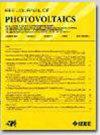Improved Lead Halide Perovskite Films and Devices Using Hot-Flow-Assisted Annealing
IF 2.6
3区 工程技术
Q3 ENERGY & FUELS
引用次数: 0
Abstract
Physical and chemical controlling of the lead halide perovskite films is crucial to minimize defects and improve overall performance and stability of perovskite solar cells. In this study, applying a hot flow of dry air on the surface of perovskite films during hot plate annealing is investigated. We found that this technique leads to a smooth texture and reduces the surface defects. A hot dry airflow of 15 L/min improves the power conversion efficiency from 13.56% to 15.31%, with approximately 4.3% and 10.4% enhancement of fill factor and short-circuit current density, respectively. However, increasing the rate of dry airflow leads to large voids, which is a critical concern for leakage current and performance degradation.利用热流辅助退火技术改良卤化铅过氧化物薄膜和器件
卤化铅钙钛矿薄膜的物理和化学控制是减少缺陷和提高钙钛矿太阳能电池整体性能和稳定性的关键。本文研究了热板退火过程中在钙钛矿薄膜表面施加热流干燥空气的方法。我们发现这种技术可以产生光滑的纹理并减少表面缺陷。15 L/min的热干气流使功率转换效率从13.56%提高到15.31%,填充系数和短路电流密度分别提高约4.3%和10.4%。然而,增加干燥气流的速率会导致较大的空隙,这是泄漏电流和性能下降的关键问题。
本文章由计算机程序翻译,如有差异,请以英文原文为准。
求助全文
约1分钟内获得全文
求助全文
来源期刊

IEEE Journal of Photovoltaics
ENERGY & FUELS-MATERIALS SCIENCE, MULTIDISCIPLINARY
CiteScore
7.00
自引率
10.00%
发文量
206
期刊介绍:
The IEEE Journal of Photovoltaics is a peer-reviewed, archival publication reporting original and significant research results that advance the field of photovoltaics (PV). The PV field is diverse in its science base ranging from semiconductor and PV device physics to optics and the materials sciences. The journal publishes articles that connect this science base to PV science and technology. The intent is to publish original research results that are of primary interest to the photovoltaic specialist. The scope of the IEEE J. Photovoltaics incorporates: fundamentals and new concepts of PV conversion, including those based on nanostructured materials, low-dimensional physics, multiple charge generation, up/down converters, thermophotovoltaics, hot-carrier effects, plasmonics, metamorphic materials, luminescent concentrators, and rectennas; Si-based PV, including new cell designs, crystalline and non-crystalline Si, passivation, characterization and Si crystal growth; polycrystalline, amorphous and crystalline thin-film solar cell materials, including PV structures and solar cells based on II-VI, chalcopyrite, Si and other thin film absorbers; III-V PV materials, heterostructures, multijunction devices and concentrator PV; optics for light trapping, reflection control and concentration; organic PV including polymer, hybrid and dye sensitized solar cells; space PV including cell materials and PV devices, defects and reliability, environmental effects and protective materials; PV modeling and characterization methods; and other aspects of PV, including modules, power conditioning, inverters, balance-of-systems components, monitoring, analyses and simulations, and supporting PV module standards and measurements. Tutorial and review papers on these subjects are also published and occasionally special issues are published to treat particular areas in more depth and breadth.
 求助内容:
求助内容: 应助结果提醒方式:
应助结果提醒方式:


